CAI Retrospektive: Agile Retrospektiven online gestalten mit CAI-Tools
A wide range of tools with system and substance.
Always prepared, well thought out, effective.
More than 75 tools in 11 formats.
Agenda
Die Agenda unterstützt bei der Festlegung der Timeboxes für die Retrospektive und dokumentiert das Ergebnis für alle sichtbar in der Sitzung.
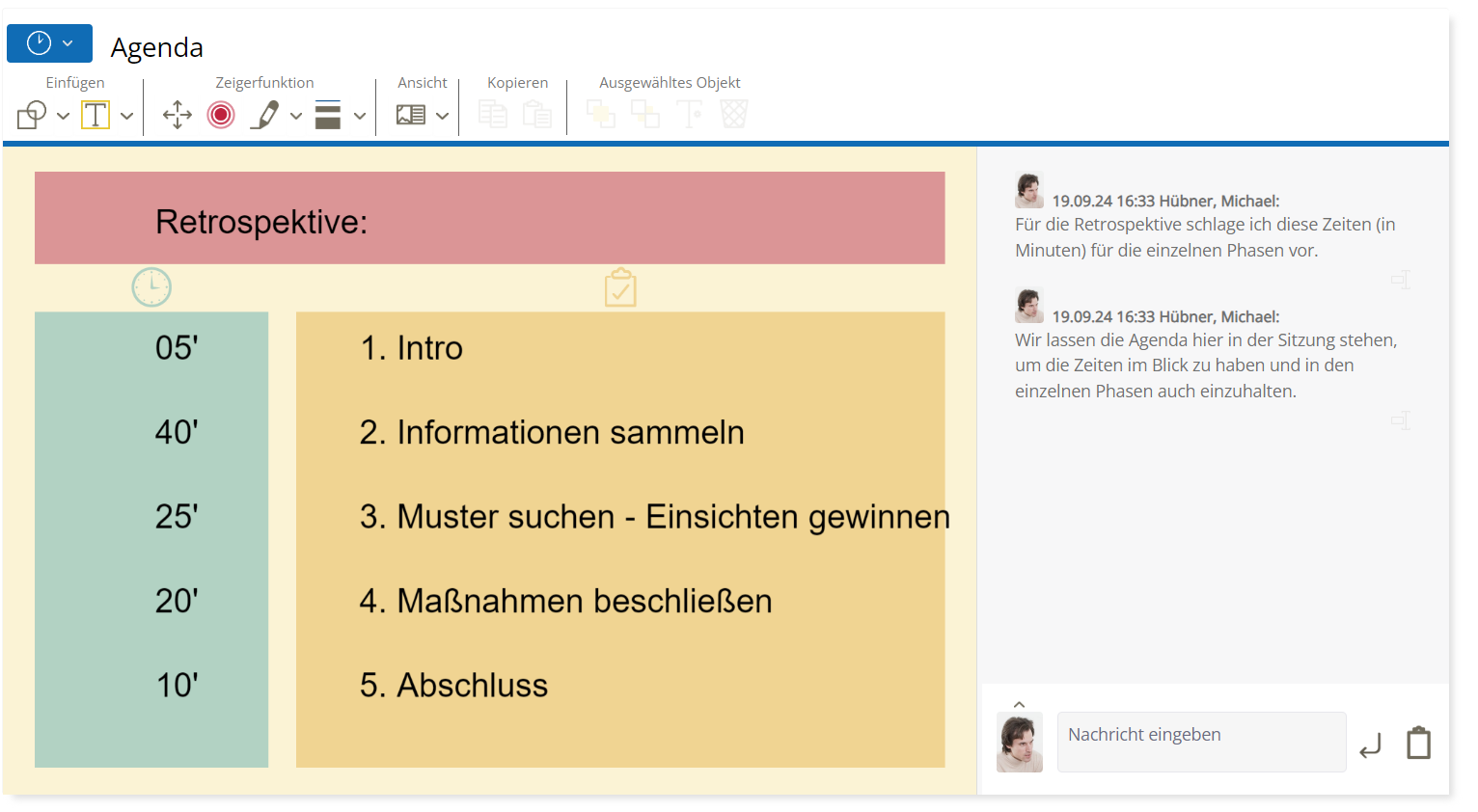
Task List
Capture and manage tasks in a structured way with the Task List
The Task List is a versatile tool for professional task management in digital work and development processes. Actions, to-dos, and next steps can be clearly recorded, prioritized, and assigned to individuals – much more structured than on a classic whiteboard.
An integrated editor allows you to document even extensive content in a formatted way. Tasks can be filtered by assignee, priority, or due date. If tasks are overdue, a notification is automatically triggered – keeping deadlines and responsibilities in view at all times. Notifications can be managed via My Account.
A special advantage: The Task List persists across sessions. Open items can be picked up and continued in follow-up meetings – ideal for continuous collaboration and sustainable results.
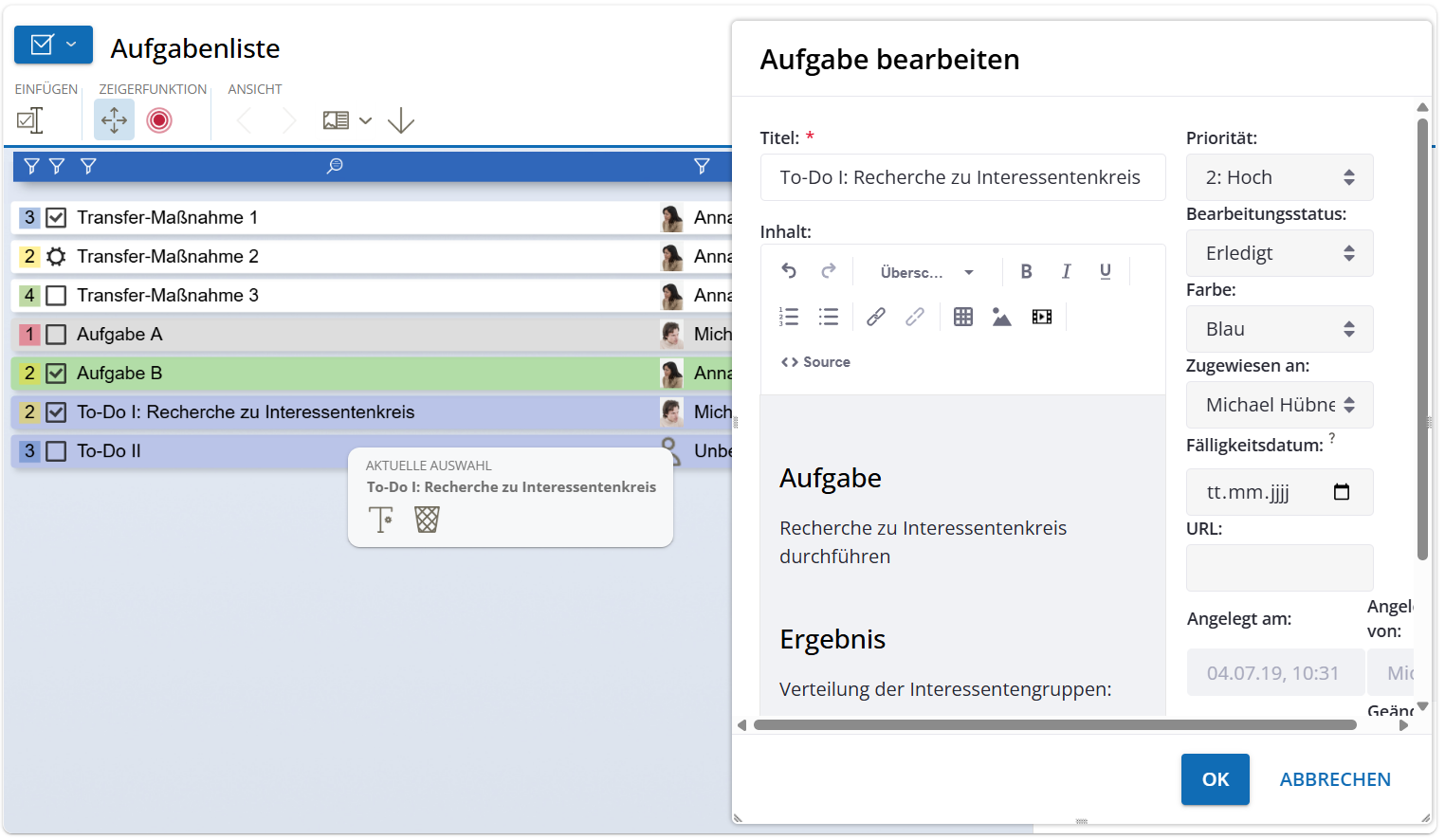
Typical use cases:
- Consulting, coaching, and supervision: Document actions and track progress
- Project work and team processes: Clarify and structure responsibilities
- Education and teaching: Record learning steps and support individual development
- Organizational development: Make change processes transparent and binding
- Training and workshops: Distribute tasks and secure results
Benefits:
- Structure and accountability: Clearly assign, prioritize, and schedule tasks
- Sustainability in the process: Continue open items across sessions
- Efficient collaboration: Filtering and notifications simplify task management
- Professional documentation: Record content clearly and in a formatted way
Image Gallery
Activates resources and creates emotional access
The Image Gallery is a versatile tool for visual support in coaching processes. In this tool, clients can select from a variety of images those motifs that symbolize their current state. This visual representation serves as a starting point for reflection and the development of a desired target state.
For individual customization, the following options are available:
- various background graphics
- colored text cards
- flexibly placeable image elements
- as well as the ability for coach or coachee to use their own images – for maximum relevance and personal engagement.
Benefits in coaching:
The Image Gallery promotes self-reflection, activates resources, and creates emotional access – particularly valuable in change processes, when working with teams, or in leadership development.
Chat
Context-based communication with question sets & automatic documentation in the chat
Chat in CAI® World is more than just a side channel – it can be directly linked to all graphical tools in CAI® World. This allows content to be exchanged in context and automatically documented.
Whether as a supplement to voice communication or as the main form of communication for asynchronous work – the chat offers maximum flexibility and secures important information.
Thanks to integrated, scientifically grounded and practice-tested question sets, coaches, leaders, and facilitators receive immediately usable prompts. Depending on the edition, these can even be individually expanded and customized – for efficient, goal-oriented communication directly in the process.

Desktop Sharing
Screen sharing without installation – share content live directly in the Desktop Sharing tool
With integrated Desktop Sharing in CAI® World, you can easily share your entire screen or a single window with other session participants – in real time and without additional software installation. This allows external applications to be seamlessly integrated into your session.
In addition to the primary camera, external cameras can also be integrated as separate video sources and displayed in Desktop Sharing. This opens up new possibilities – for example, visualizing physical objects, whiteboards, or handwritten sketches in real time.
Whether for interactive training, joint process analysis, or collaborative work: Desktop Sharing makes it possible to display content and further develop it directly in dialogue.
The transmission is based on modern WebRTC technology – secure, stable, and browser-based. Important: Sharing your own screen is currently not possible via iPhone or iPad.
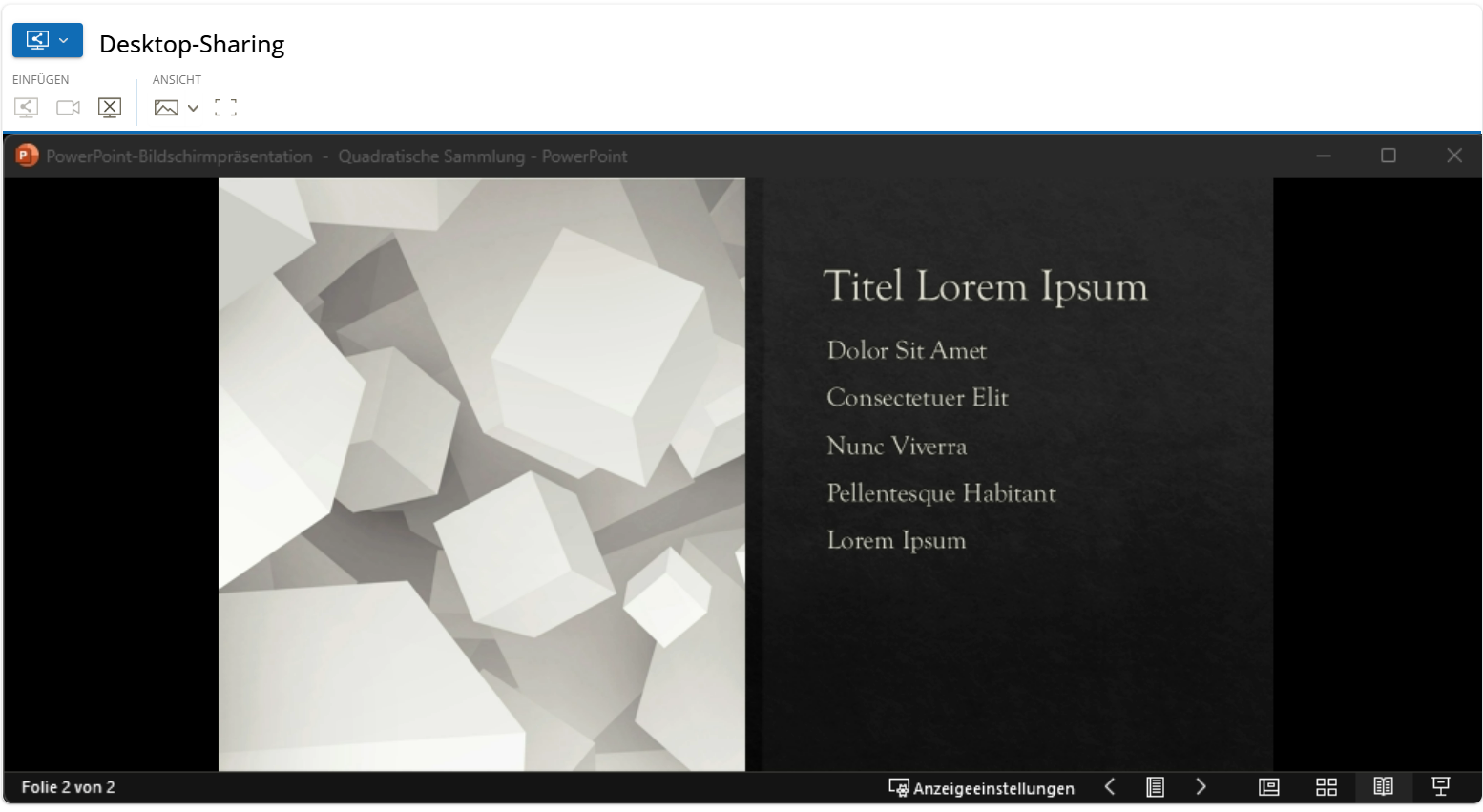
At a glance:
- Flexible screen sharing: Entire screen or specific window
- Integrate external cameras: More perspectives for more context
- No installation required: Runs directly in the browser
- Easy integration of external tools: Ideal for training & demonstrations
- Secure & GDPR-compliant: WebRTC technology
Kraftfeld-Analyse
Was hilft – und was hindert? Kräfte erkennen und gezielt nutzen.
Die Kraftfeld-Analyse ist ein bewährtes Instrument zur strukturierten Betrachtung komplexer Situationen. Sie hilft dabei, die Kräfte zu identifizieren, die auf ein bestimmtes Thema oder eine Fragestellung einwirken – sowohl unterstützende als auch hemmende. Durch die Gegenüberstellung dieser Einflussfaktoren entsteht ein differenziertes Bild, das dabei unterstützt, Zusammenhänge besser zu verstehen und gezielt an Lösungen zu arbeiten. Dies ermöglicht es, gezielt an Stellschrauben zu arbeiten: förderliche Faktoren zu stärken und hemmende Einflüsse zu reduzieren.
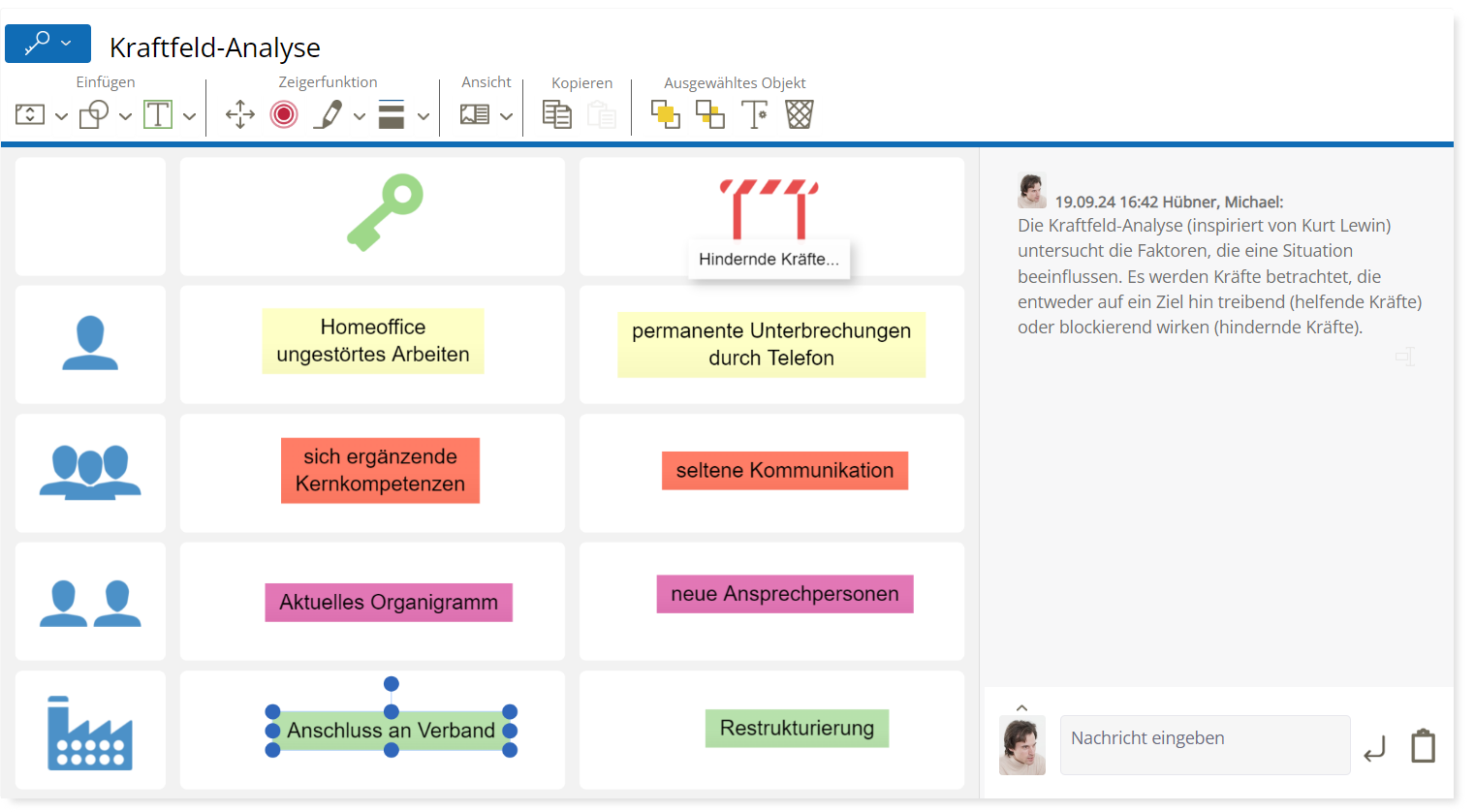
Nutzen des Tools
- Unterstützt die Analyse komplexer Situationen
- Macht förderliche und hemmende Einflüsse sichtbar
- Fördert strategisches Denken und zielgerichtetes Handeln
- Hilft, Prioritäten für Interventionen zu setzen
- Vielseitig einsetzbar: in Coaching, Teamprozessen, Organisationsentwicklung und Projektarbeit
Kreisdiagramm
Verteilungen auf einen Blick erfassen im Kreisdiagramm
Das Tool Kreisdiagramm dient in der CAI® World der anschaulichen Darstellung von Anteilen, Verteilungen und Gewichtungen. Durch die visuelle Aufbereitung in Form eines Kreises mit Segmenten wird sofort ersichtlich, wie sich einzelne Elemente zueinander verhalten – sei es bei der Einschätzung von Rollenanteilen, Zeitverwendung, Themengewichtung oder Ressourcenverteilung.
Die grafische Darstellung erleichtert die Bewertung komplexer Zusammenhänge und unterstützt die gemeinsame Reflexion. Kreisdiagramme fördern das Verständnis und die Kommunikation über Zahlen, Verhältnisse und Prioritäten – fördert Verständnis, Transparenz und Entscheidungsfähigkeit.
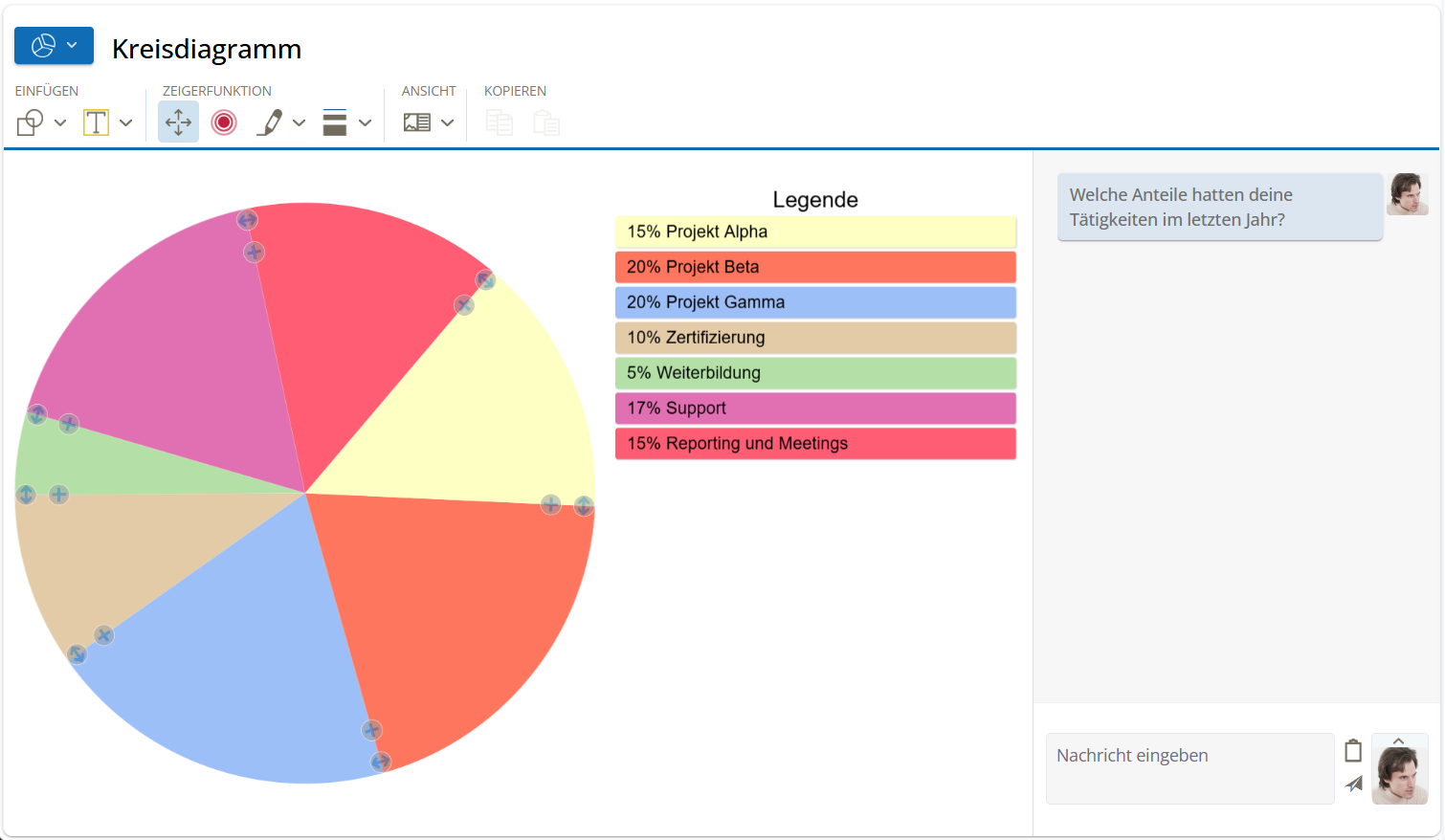
Nutzen
- Macht Verteilungen und Gewichtungen visuell erfassbar
- Unterstützt die gemeinsame Einschätzung und Diskussion
- Ideal für Analyse und Entscheidungsfindung
Maßnahmenplanung
Vom Ziel zur Umsetzung: Maßnahmen festlegen, Verantwortlichkeiten klären
Wer macht was bis wann – die Maßnahmenplanung bringt es auf den Punkt. Das Tool zeigt auf einen Blick, was zu tun ist, wie es umgesetzt werden soll, bis wann es erledigt sein muss, wer verantwortlich ist und wie der Erfolg überprüft wird. Damit wird aus Ideen und Erkenntnissen ein umsetzbarer Plan.
Im Unterschied zur Aufgabenliste, die Aufgaben in tabellarischer Form mit detaillierten Beschreibungen und Eigenschaften verwaltet, bietet die Maßnahmenplanung einen kompakteren, visuelleren Zugang – ideal für kleinere Vorhaben, Workshops oder Coaching-Sessions.
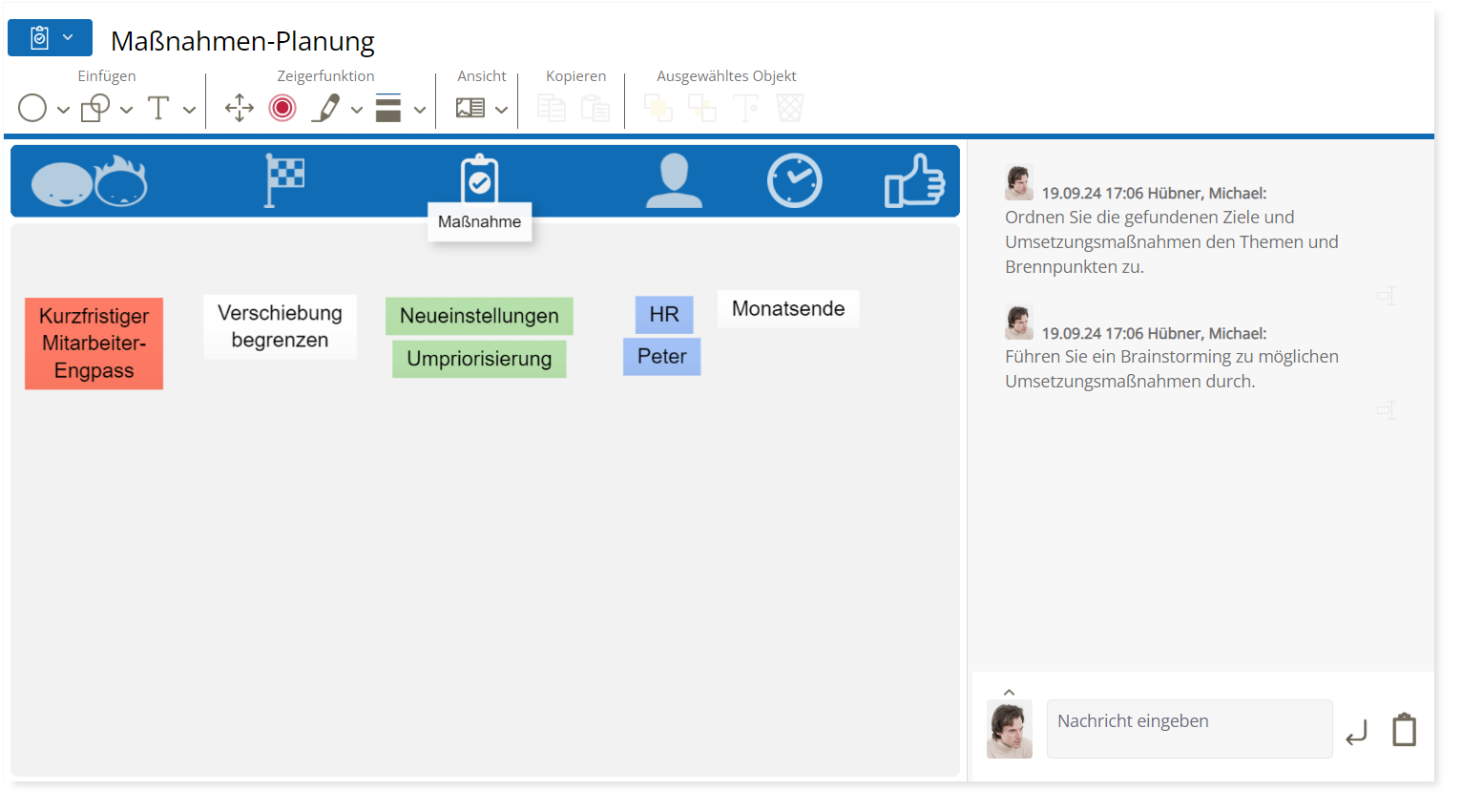
Nutzen des Tools Maßnahmenplanung
- Unterstützt die strukturierte Umsetzung von Zielen und Vereinbarungen
- Fördert Verbindlichkeit und Verantwortungsübernahme
- Macht Aufgaben, Zuständigkeiten und Zeitrahmen transparent
- Ermöglicht eine einfache Erfolgskontrolle
Media Player
Use Videos and Audios Effectively with Integrated Media Playback
The Media Player tool enables video and audio content to be shared directly within the digital meeting room of CAI® World – without external platforms. Whether for knowledge transfer, as a stimulus for discussions, or to deepen exercises: media can be centrally started, paused, and precisely controlled. Individual playback by participants is also possible, for example for review or self-directed learning.
The content remains securely stored on the platform and is available at any time – ideal for structured, media-supported workflows.

Benefits at a Glance
- Shared or individual media playback
- Central control by the moderator (start, pause, position)
- No external hosting service required
- Secure access to protected content
- Versatile use for learning, reflection, and inspiration
Presentation
Display and use documents together
With the Presentation tool, documents such as PDFs, images, or Office files can be displayed directly in the session and viewed together. Materials can be selected from the existing document library or uploaded anew – without external applications or separate screen sharing.
The moderator retains control over the display and can manage content as needed. This ensures efficient, clear, and secure integration of documents.
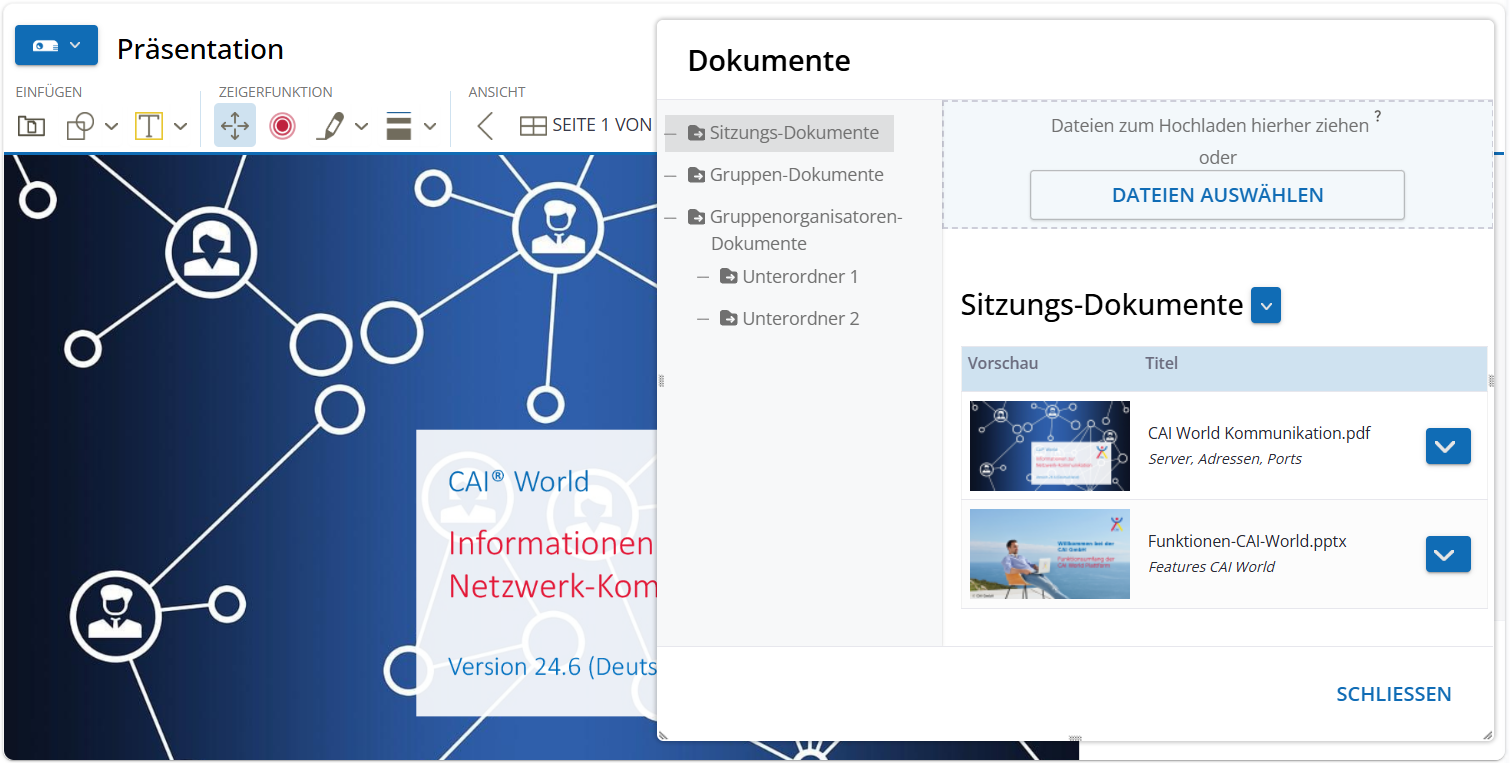
Benefits at a glance
- Shared display of documents and materials
- Support for various file formats (PDF, images, Office)
- Direct access to the document library
- Moderator control for focused work
- Secure and integrated – without external tools
Ressourcen und Motivatoren
Was stärkt, was begeistert
Das Tool Ressourcen und Motivatoren unterstützt dabei, positive Einflussfaktoren im Arbeitskontext sichtbar zu machen. Es hilft Einzelpersonen und Teams zu erkennen, welche Unterstützung bereits vorhanden ist, welche Arbeitsbedingungen förderlich wirken und was Freude und Motivation im Alltag bringt.
Durch die gezielte Reflexion dieser Aspekte entsteht ein wertvoller Überblick über bestehende Stärken und Potenziale. Das Tool eignet sich besonders zur Förderung von Selbstwirksamkeit, zur Teamanalyse oder zur Vorbereitung von Entwicklungsgesprächen.
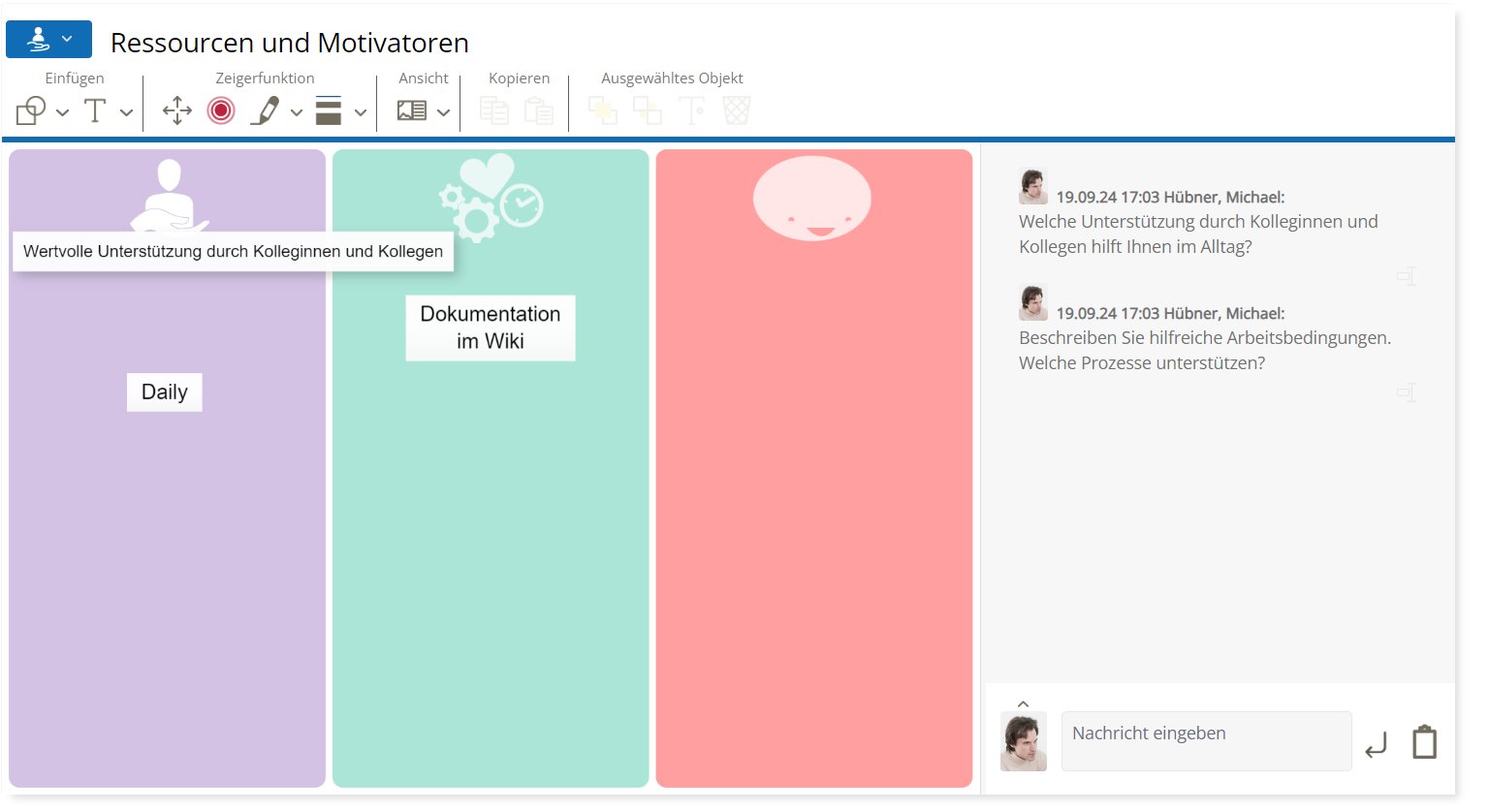
Nutzen im Überblick
- Macht vorhandene Unterstützung und hilfreiche Rahmenbedingungen sichtbar
- Fördert die Selbstreflexion und das Bewusstsein für motivierende Faktoren
- Unterstützt die Entwicklung einer positiven Arbeitskultur
- Stärkt Eigenverantwortung und Teamzusammenhalt
Sociogram
Reveal relationship dynamics and initiate change with the Sociogram
The Sociogram is an effective tool for visualizing relationship structures within groups, teams, or other social systems. It enables a clear representation of proximity, distance, and the quality of interpersonal relationships – from trusting to conflictual.
Through the graphical arrangement of the involved individuals, patterns and dynamics can be identified that often remain hidden in everyday life. For example, role distributions, coalitions, or areas of tension can be made visible and addressed in a targeted manner.
Typical use cases:
- Analysis of team structures and communication paths
- Preparation and support of change processes
- Conflict resolution and improvement of collaboration
Benefits:
The Sociogram creates transparency in social systems, promotes understanding of relationship dynamics, and supports targeted interventions to improve collaboration and team climate.
Sternstunden
Positive Momente sichtbar machen – die Sternstunden
Besonders gelungene Ereignisse verdienen es, erinnert und gewürdigt zu werden – genau hier setzt das Tool Sternstunden an. Es unterstützt Einzelpersonenen und Teams dabei, motivierende Erfahrungen wie erfolgreiche Projekte, wertschätzendes Feedback oder verbindende Teamerlebnisse gemeinsam zu reflektieren und auf einer Zeichenfläche in Form von „Sternen“ festzuhalten.
Die Visualisierung positiver Erfahrungen fördert nicht nur die Wertschätzung, sondern schafft auch emotionale Anker für zukünftige Zusammenarbeit. Das Tool eignet sich für Teamentwicklung, Führungskräfte-Coaching oder zur Stärkung von Motivation und Zusammenhalt.
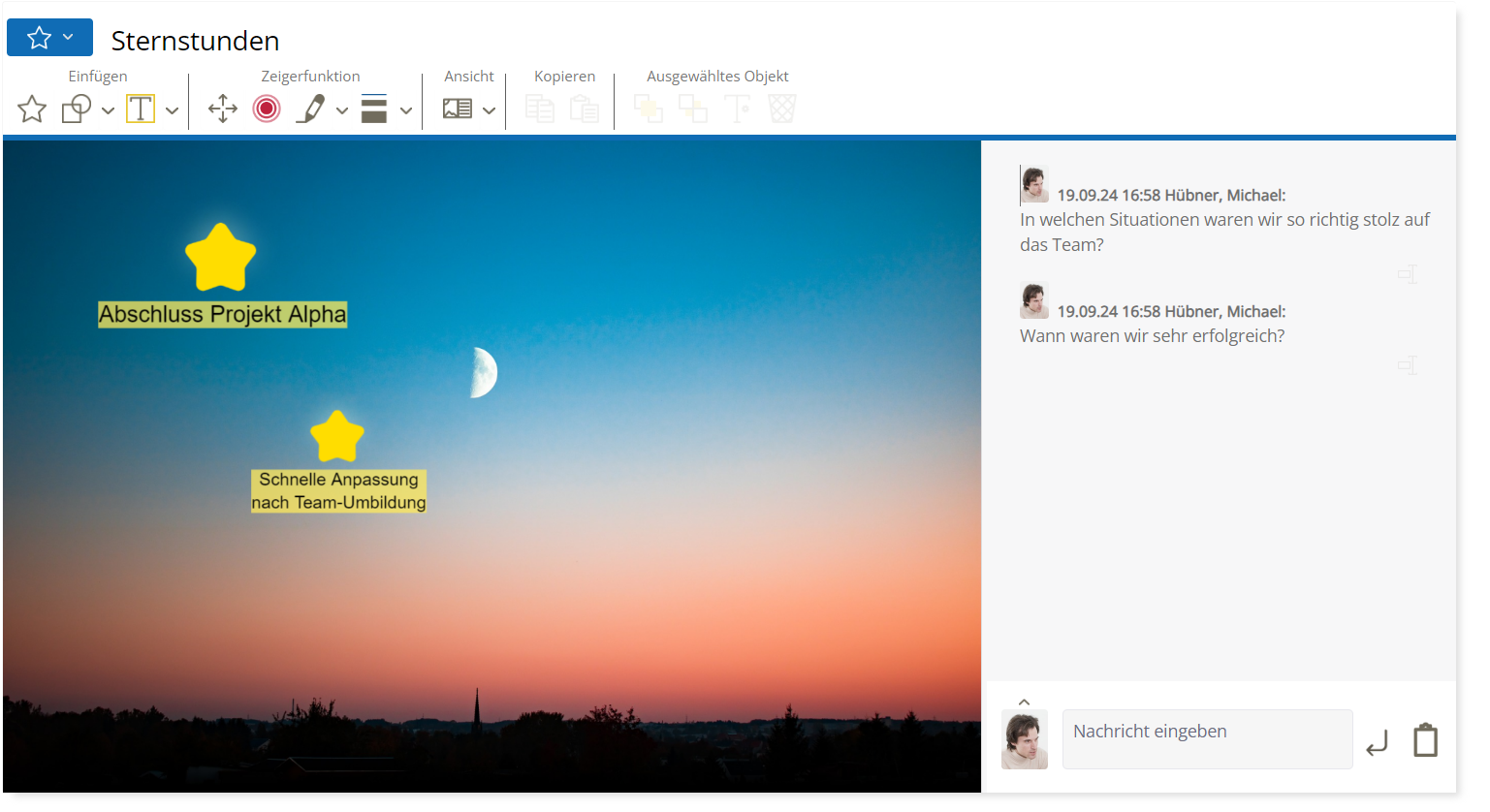
Nutzen des Tools „Sternstunden“
- Fördert den Zusammenhalt durch gemeinsame Erinnerung
- Stärkt Motivation und positive Identifikation
- Macht Erfolge und wertvolle Erfahrungen sichtbar und greifbar
- Unterstützt eine ressourcenorientierte Perspektive
System Image
Identify systemic connections with the System Image
The System Image is a flexible visualization tool in CAI® World for representing relationships, roles, and dynamics within a social or organizational system. It is based on the method of systemic constellation and is suitable for depicting both current situations and desired scenarios.
By arranging system members spatially, influences, proximity and distance, as well as hidden tensions become visible. This creates new perspectives on complex interconnections – intuitive, creative, and solution-oriented.
The tool offers a variety of customization options:
- Neutral, single-color backgrounds with simple figures
- Or a wide selection of symbols, colors, and backgrounds for individual visualization
Benefits at a glance
The System Image promotes systemic thinking, creates clarity about relationship networks, and supports the development of new courses of action – in individual coaching as well as in work with teams or organizations.
Team clock
The team development clock as a phase model for group dynamics was originally developed by B. Tuckman. According to this, groups go through the four phases shown, or as a fifth phase, the resolution (adjourning).
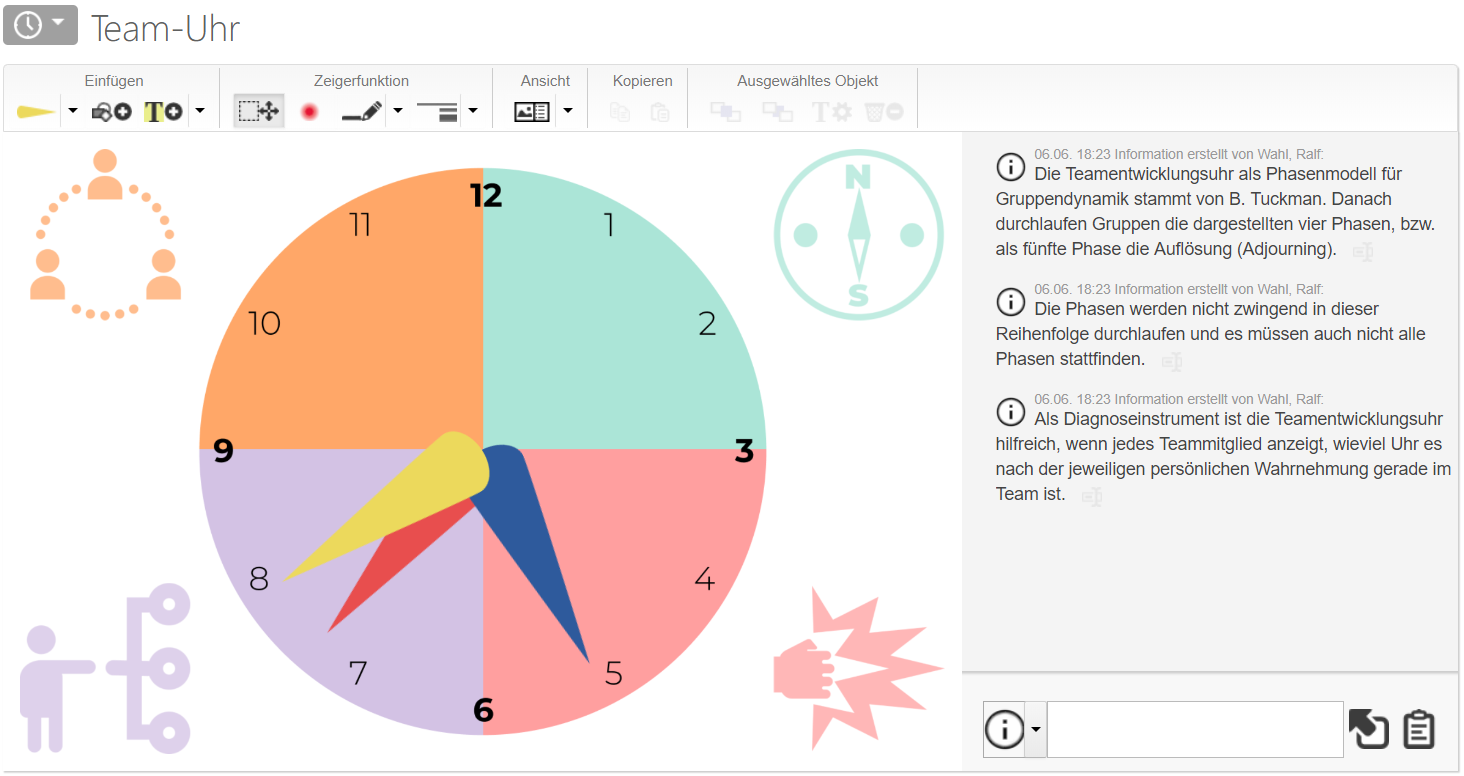
Themen & Brennpunkte
Was jetzt zählt: Themen mit Priorität erkennen
Ob im Coaching oder in der Teamarbeit – Themen & Brennpunkte schafft Übersicht über das, was wirklich zählt. Es unterstützt Teams, Führungskräfte und Coachs dabei, herauszufinden, welche Themen aktuell wichtig sind, welche emotional aufgeladen sind und wo akuter Handlungsbedarf besteht.
Durch die Visualisierung entsteht ein gemeinsames Verständnis darüber, welche Themen priorisiert werden sollten – sei es in Teamprozessen, Mitarbeitergesprächen, Strategie-Workshops oder im Coaching.
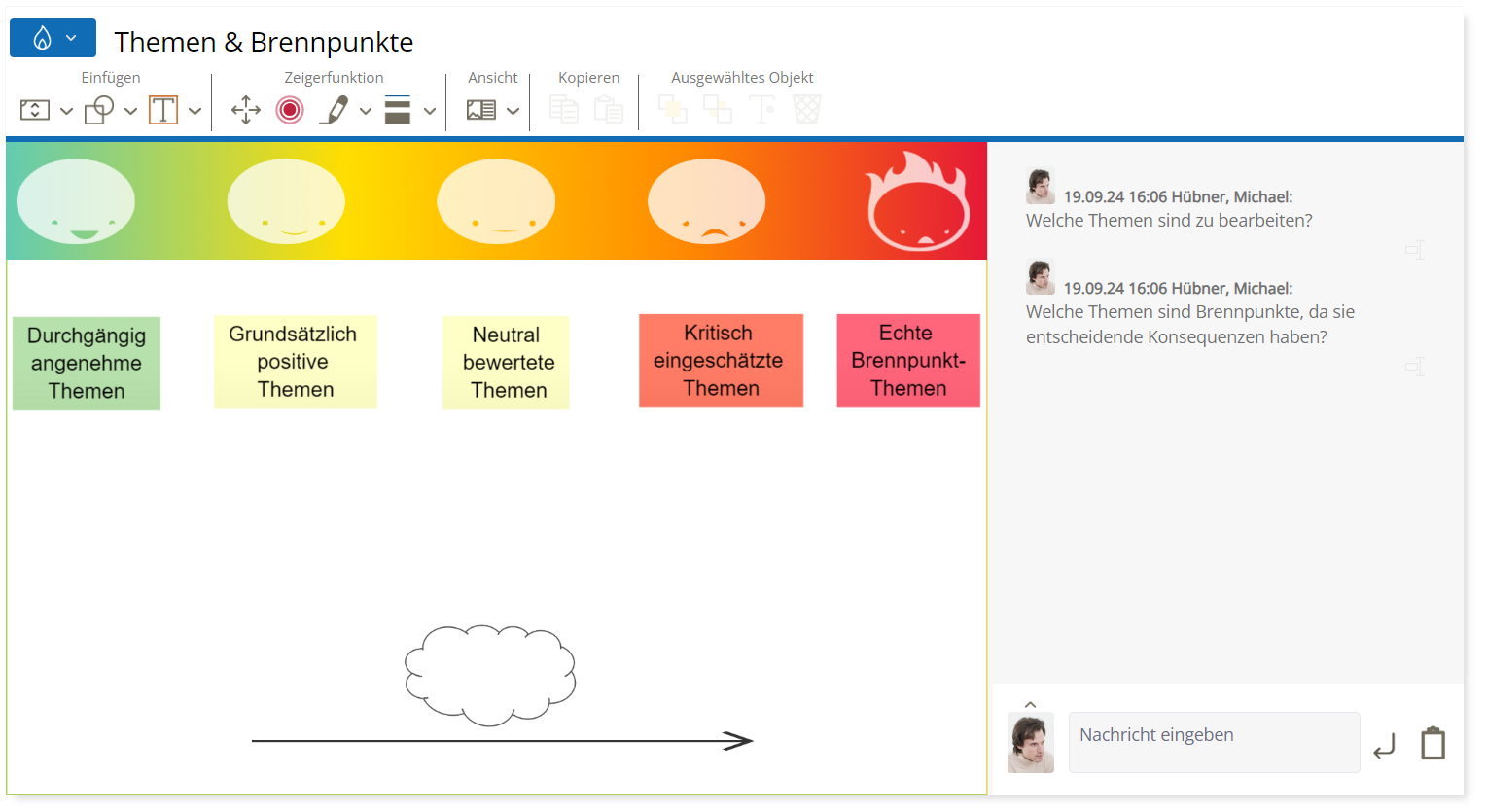
Nutzen des Tools
- Relevante Themen werden gesammelt, geordnet und priorisiert
- Brennpunkte mit hoher emotionaler oder sachlicher Dringlichkeit werden sichtbar
- Teams entwickeln ein gemeinsames Verständnis für aktuelle Herausforderungen
- Unterstützt die Fokussierung auf das Wesentliche
- Fördert zielgerichtete Diskussionen und Entscheidungen
Wertschätzende Erkundung
Wertschätzung als Motor für Entwicklung
Das Tool Wertschätzende Erkundung hilft Teams und Organisationen dabei, bewusst wahrzunehmen, was bereits gut funktioniert und geschätzt wird. Es fördert eine positive Perspektive auf Zusammenarbeit, Kultur und Aufgaben.
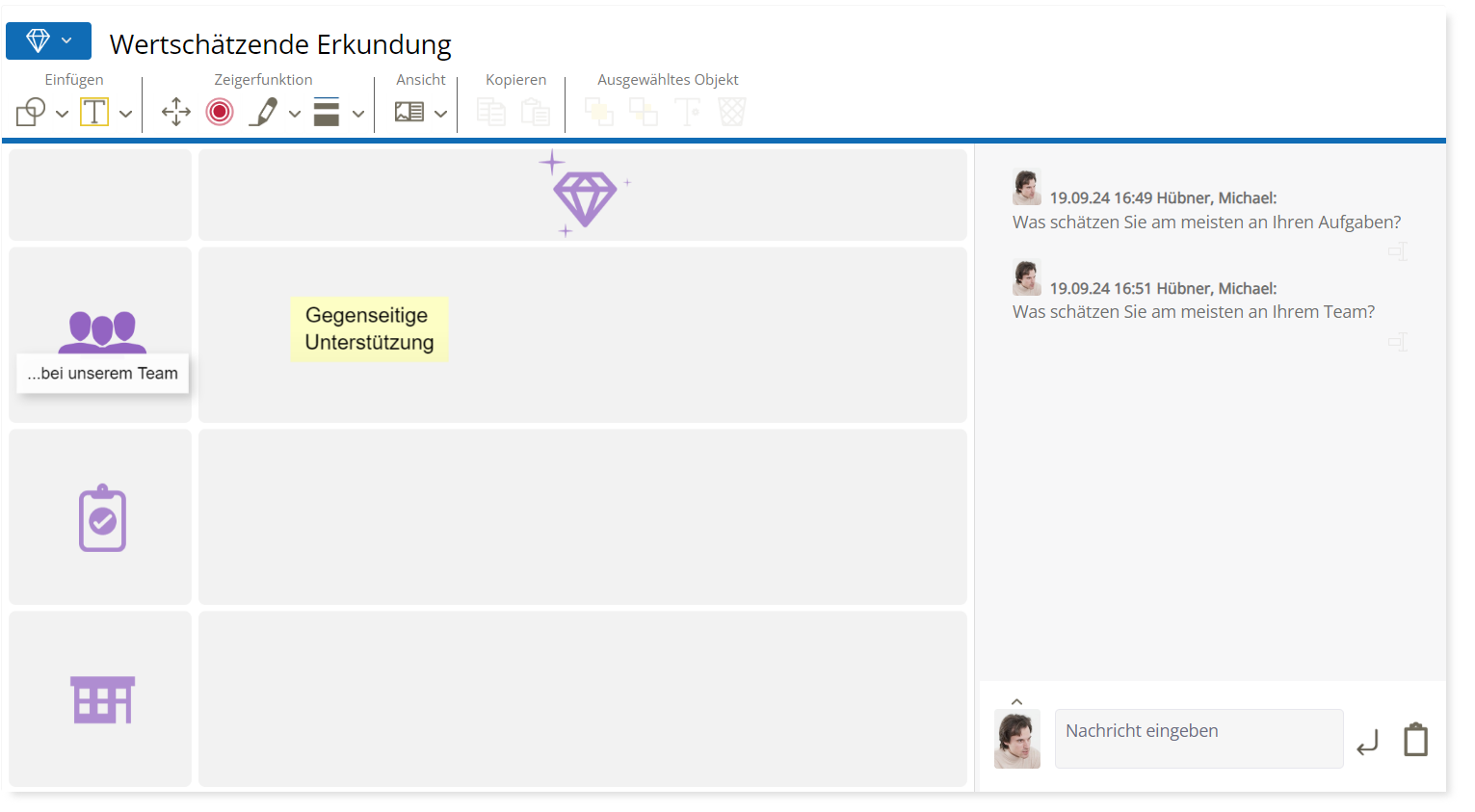
Nutzen
- Fokus auf Stärken und Erfolge
- Förderung von Motivation und Zusammenhalt
- Aktivierung vorhandener Ressourcen
Whiteboard
A space for everything: ideas, structure, creativity. The digital whiteboard.
The Whiteboard tool provides a flexible space for visualizing, structuring, and collaboratively developing content – digital, location-independent, and interactive. Comparable to flipcharts or moderation boards, but with significantly expanded possibilities: drawing elements, symbols, custom graphics, and individual backgrounds support creative and structured work processes.
All content can be edited, saved, or duplicated at any time – ideal for dynamic work in groups, workshops, training sessions, or projects.
Benefits at a glance
- Interactive visualization of ideas, topics, and processes
- Wide selection of symbols, shapes, and backgrounds
- Easy integration of custom graphics and backgrounds
- Results automatically saved and accessible at any time
-
Zielgerade
Standortbestimmung auf dem Weg zum Ziel
Mit dem Tool Zielgerade visualisiert eine Einzelperson oder ein Team die aktuelle Position in Bezug auf ein definiertes Ziel. Über einen Schieberegler lässt sich der Fortschritt einschätzen und reflektieren, warum das Team gerade dort steht – und was es braucht, um weiterzukommen.
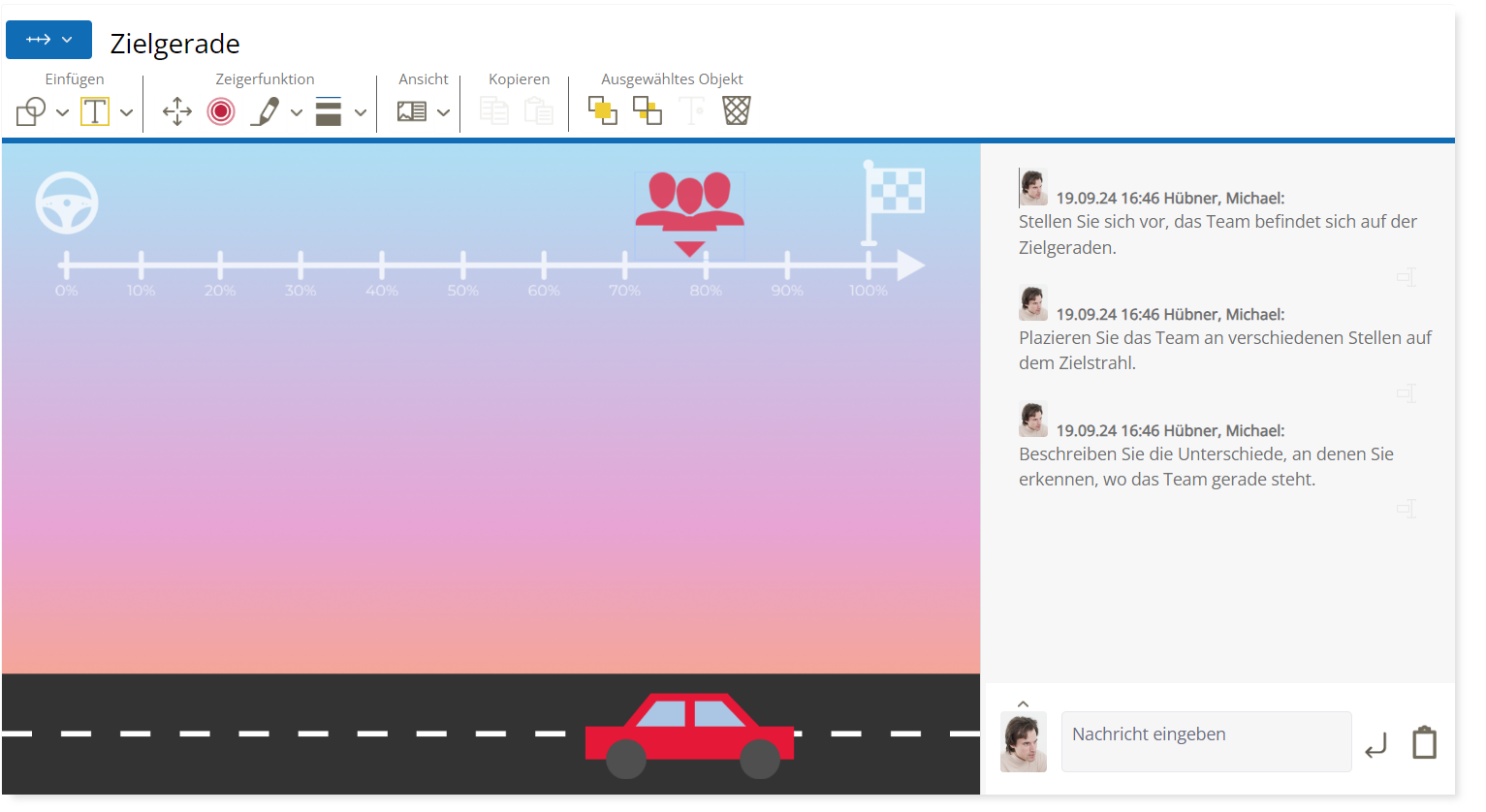
Nutzen auf einen Blick
- Klare Standortbestimmung im Zielprozess
- Gemeinsames Verständnis über Fortschritt und Hindernisse
- Förderung von Zielklarheit und Motivation
- Grundlage für nächste Schritte und Maßnahmen
Ideal für Projektteams, Retrospektiven oder zur Zwischenbilanz in Veränderungsprozessen.
CAI® World Formats
Discover these formats with their respective tools:

